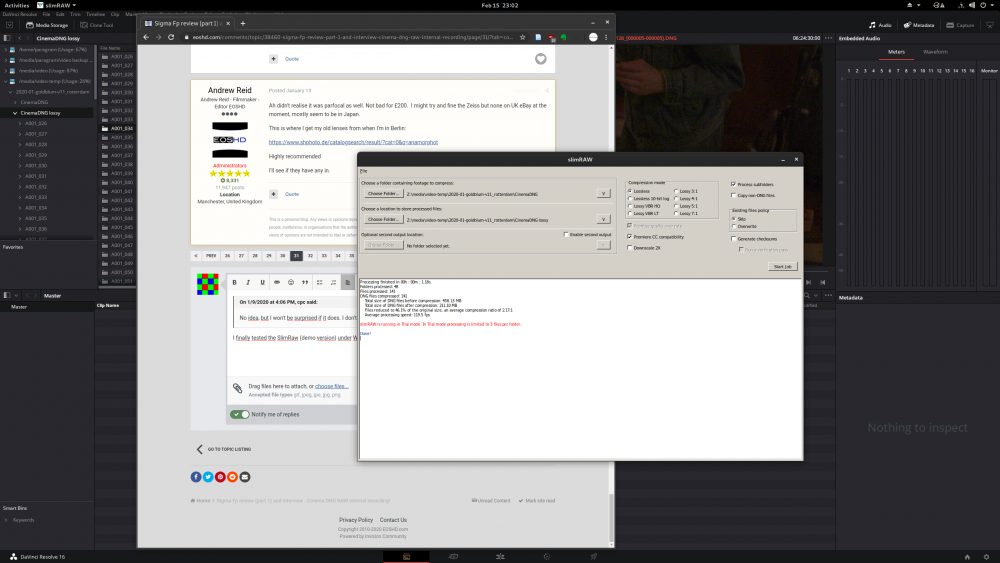-
Posts
321 -
Joined
-
Last visited
Content Type
Profiles
Forums
Articles
Everything posted by rawshooter
-
Now, Photokina has been cancelled... https://www.fujirumors.com/photokina-2020-canceled-due-to-coronavirus-outbreak-and-postponed-to-may-2022/
-
In the early 2000s, the British experimental filmmaker John Smith made a series of videos made in hotel rooms, each of them shot in only one of them: He also made this brilliant 16mm film in London, in 1976:
-
The sad truth is that, in order to scan 35mm and medium format stills in best quality, you need dedicated high-end film scanners like the ones made by Nikon (Coolscan) and Hasselblad (Flextight). Nikon unfortunately stopped manufacturing the Coolscans many years ago. Today, they are sought-after items costing up to $2000 on Ebay, with many models needing SCSI or Firewire connections. Hasselblad scanners cost about $15,000. All affordable solutions on the market, flatbed scanners (like the Epson Perfection series or the Reflecta budget film scanners) do not render the full quality of film. Solutions for digitizing film with a camera and a macro lens like the Nikon ES-2 lens adapter are rather flimsy.
-
The source material is 12bit UHD CinemaDNG, and no matter whether I transcode with Slimraw to losslessly compressed or 3:1 CinemaDNG, Resolve doesn't recognize the files CinemaDNG, only as separate image sequences and audio files.
-
Finally bought a SlimRaw license - but still, with 1.8.3, I keep having the problem that Resolve (16.2) doesn't recognize the CinemaDNG files as CinemaDNG files, only as DNG stills sequences and separate audio files. Is there a workaround?
-
Sigma fp with CinemaDNG is excellent for low light, especially if you denoise with Neat Video Pro.
-
Visit the Dr. Caligari exhibition at Deutsche Kinemathek film museum: https://www.deutsche-kinemathek.de/de/besuch/ausstellungen/du-musst-caligari-werden-das-virtuelle-kabinett Also check out the program of Arsenal film theater in the same building, which will show repeat screenings of the Forum section of this year's Berlin film festival, among others: https://www.arsenal-berlin.de/en/home.html There are two foto museums, CO Berlin: https://www.co-berlin.org/article/exhibitions and Helmut Newton Foundation with a recommendable exhibition on performance artists and photography: https://helmut-newton-foundation.org/en/
-
"SIGMA is also developing firmware Ver.1.02, which corrects card errors when using certain SD cards, and introduces added lens aberration correction processing. This is scheduled to be released on Wednesday 18th March 2020." I wonder whether this will fix the manual exposure bug. Doesn't sound like it...
-
No, because it's RAW sensor data - all sampling is done in post (except for the downsampling from 6K to 4K).
-
-
This will be your best bet - only that there's no standard LUT/transformatio from this material to Rec709 or other color spaces.
-
-
At least it's a known issue with smartphone OLEDs: https://www.androidpit.com/how-to-fix-screen-burn-in (And I'd guess that smartphones get thrown away/replaced much faster than cameras. I would want a camera display to be usable ten years or longer... No reason to throw away, for example, a GH2 [released in 2010] or a 5D MkII [released in 2008 and still great with MagicLantern].) OLED EVFs shouldn't be critical, since EVFs normally only turn on when triggered by eye sensors, so it should be hard to ever reach sufficient running time for an overlay to burn in. And even you don't get a straight-forward burn-in, OLEDs deteriorate and become dim with age (because they are organic material).
-
It's enough if you have your camera, for example, in "M" mode and with an "M" displayed as an overlay on your screen. The "M" will burn in after some time, no matter whether the camera is constantly running or being switched off in between. That's why even LG, the main manufacturer of OLEDs, is currently developing new display technologies for its high-end TVs. "OLED burn in" is a well-known issue (the same as with plasma tv screens in the past) and currently yields 3.6 million results in a Google search... It is not something that can be fixed within OLED technology itself.
-
No, but all your menu overlays.
-
OLEDs are problematic as camera displays because of their image burn-in - especially of fixed UI overlays. It's a principal issue of the technology. Here's a monochrome image of an OLED tv that showed CNN for 36 weeks:
-
Obviously, the above picture was taken with an anamorphic lens...
-
The problem is that Canon, like all big camera manufacturers, uses an ASIC architecture for the camera electronics and signal processing: single-purpose boards where most functions are hard-wired, allowing smaller bodies, less cooling and lower manufacturing costs in high volumes. To implement ProRes, Canon would need to develop a new ASIC from scratch, which is expensive, and is only done every couple of camera generations, with one ASIC for all current Canon SLR and mirrorless cameras. Blackmagic, Arri and RED and other smaller manufacturers use FPGA instead of ASIC: fully programmable boards (or mini computers) where new codecs and functions can be implemented in software. While FPGAs are more flexible and cheaper to develop initially, they are larger, require more cooling andbigger camera housings, and are more expensive to manufacture per piece than ASICs. The Blackmagic Pocket Cinema 4K and 6K cameras are good examples for those advantages and disadvantages of the FPGA architecture. The Sigma fp is a good example for the advantages of ASIC (smaller body with a full frame sensor), but also for the disadvantages (lots of limitations that likely can't be fixed in firmware).
-
I watched the download. 12bit off a 14bit sensor creates problems with dynamic range if the sensor values are stored as linear values. Blackmagic, as far as I know, encodes 12bit raw values with a logarithmic function and thus preserves more dynamic range. The Sigma fp's sensor should, by itself, have no worse dynamic range than the sensors of most other tested cameras...
-
It is definitely 4, since the creator of the video just wrote this on RedUser: http://www.reduser.net/forum/showthread.php?180359-Full-Frame-Cinema-Shootout-2020&p=1884748&viewfull=1#post1884748 That was expected, and confirms our observations of the camera's image quality weakness when recording full-frame 4K CinemaDNG. :-((
-
From the outdoor scene it's almost impossible to judge (too much handheld, too much background blur, too much out-of-focus shooting, lack of fine textures/details). From the studio scene: It can't be 1 (because the scaling/downsampling of small details/text is too clean compared to the Sigma's odd Bayer-to-Bayer downscaling); it's unlikely 2 (because details in this image look too artificially sharp, like it was shot with a conventional codec) It can't be 3 (for the same reasons as 1) It could be 4 - because the fine details are so blurry, just as with the 4K RAW from the 6K sensor of the fp. It can't be 5 (for the same reasons as 1 & 3) It can't be 6 (see above, although there's moiré in the fine details) It can't be 7 (see above) It can't be 8 (see above) It might be 9 because fine details are blurrier and showing moiré, but still too good IMHO So either 4 or 9, more likely 4. From the overexposed studio scene: 4 looks likely, since the Sigma fp really has no log profile and no highlight roll-off to speak of when the image clips. 9 looks too good for being that overexposed... So I'd say it's 4. The weird flashing artifacts of the underexposed studio scene are an indicator of the fp as well, if this was shot with the old firmware. - If it's 4 indeed, then it confirms what we already observed; that the Sigma fp has rather poor Raw video quality for a full frame camera and is significantly worse than the rest. If it's not 4, it would be a pleasant surprise.
-
The company is based in Bavaria...
-
The choice of codec and the preset makes no difference for the resulting file size. You simply use a tool like this one: https://www.dr-lex.be/info-stuff/videocalc.html (Video Bitrate Calculator) ...which calculates the video and audio bitrate for you, then you use Handbrake/ffmpeg, specify the same two bitrates for the encoding, and choose 2-pass (possibly with "turbo first pass" option) encoding for the highest accuracy of your video matching the desired file size.







